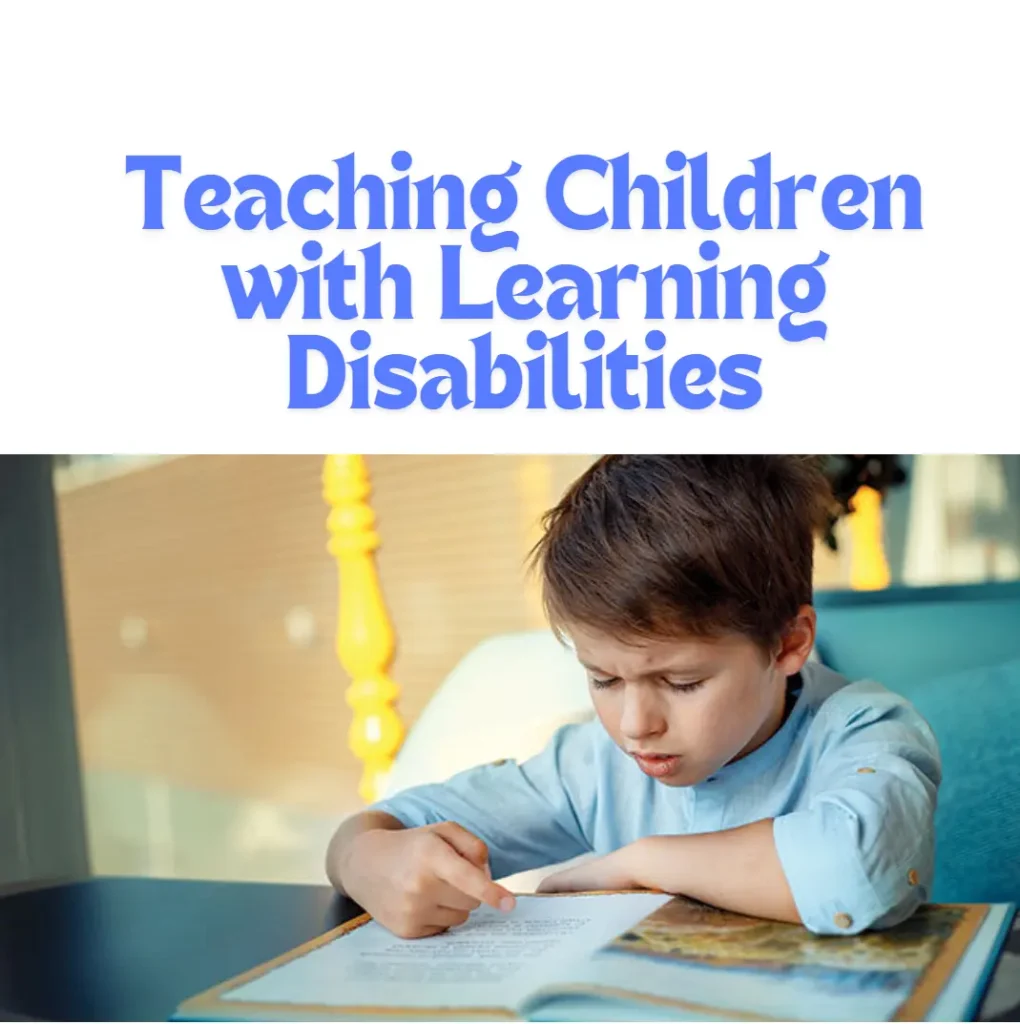Learning disabilities in children can be a significant challenge in a child’s learning path. However, with the right knowledge, approach, patience, and expectations, it can be managed. Children with learning disabilities show positive learning capabilities when techniques like multisensory approach, probing, prompting, pictures, augmented learning, peer teaching, and cooperative learning are used. Following are some strategies that would be helpful to both the parents and teachers when trying to teach children with learning disabilities.
The key basis to teach children with learning disabilities is to use a sequential, simultaneous structured multi-sensory approach. The essential principle is to treat all children and all beings equally and respect their individual needs. Learning disabilities in children are a major challenge to any parent. But, please don’t get overwhelmed by the learning disability. Learning disability in your child is just one aspect of your child’s unique neurodivergent profile. By understanding and embracing these differences, you can help your child develop resilience, self-esteem, and a strong sense of identity.
Strategies for reading skills for children with learning disabilities:
- Prepare the student by presenting new concepts and vocabulary
- Break the task into very small steps and take it one-two steps a day
- Guide the student in to reading a story by asking questions which bring up the purpose or goal of the reading
- Model instructional practices with repetition
- Develop and strengthen skills relating to the material through drills or worksheet activities
- Assign work in order to apply the skills acquired during a lesson
- Read aloud to students regularly
- Devote a few minutes every day to sustained silent reading
- Use writing activities that provide opportunities for the teacher to model writing strategies and skills.
- Include journal writing as part of the student’s individualized educational programme
- Provide meaningful printed materials in the instructional setting (e.g. dictionaries, categorized lists of words)
- Establish a network of communication with other teachers, and thus using holistic techniques in working with such students
- Let the child read aloud (oral reading). If the child makes mistakes they can be easily identified by the teacher and corrected
- Reading can be done with peers or with parents (paired reading). This will enhance the confidence of the child
- Reading in a group (choral reading). Here they get both auditory and visual stimulus to correct themselves
- Use color-coded textbooks (e.g., green equals start, red equals stop)
- Have a small group of class read aloud simultaneously
Strategies for writing skills for children with learning disabilities:
- A sufficient amount of time should be allocated for writing. (e.g. four times per week) because students can learn and develop as writers only by writing.
- Expose students to a broad range of writing tasks. Students should participate in writing activities that present highly structured problem-solving situations as well as activities that involve self-selected and expressive writing.
- Create a social climate conducive to writing development. Teachers need to be encouraged in a non-threatening environment and should try to develop a sense of community by promoting student sharing and collaboration.
- Integrate writing with subjects such as language and arts so as to stimulate the writing skills.
- Help students develop the processes central to effective writing. The composition process of writing can be divided into a series of discrete stages (e.g. prewrite, write and rewrite), and students can be taught appropriate task-specific and metacognitive strategies (e.g.self- instructional strategy training).
- Help students develop explicit knowledge about the characteristics of good writing. Students should be given exposure to the characteristics of various literary compositions either through reading or teacher presentation of writing or live models that incorporate a specific skill or style.
- Help students develop the skills and abilities to carry out more sophisticated composing processes.
- Assist students in the development of goals for improving their written products.
- Goal setting and having students evaluate their own writing according to specific criteria can help students accurately monitor and evaluate progress.
- Tape alphabets form to the floor, Have students walk or hop around the form. Have them reproduce the form with coloured yarn.
- Have students use a stick (broom handle) and their bodies to form the letters.
- Spray shaving cream can be used to form large letters. Paper provides a suitable surface.
- Have students use a torch light beam to trace letters on a chalkboard.
- Have student’s form letters in wet fingerprint/paint/sand.
- Use colored directional cues such as green arrows and red dots.
- Help students to form an association for a letter they have difficulty remembering
- Have students orally describe their movements as the letter is being written. This provides auditory reinforcement.
Strategies for mathematics for children with learning disabilities:
- Use manipulations such as buttons and beads. Let the students drop beads into a clear plastic cup and count while seeing how many beads represent the number. The child also gets auditory input to support this concept.
- Use visuals. Materials for younger students usually have a generous display of visual illustrations. Materials for older pupils tend to rely more on abstract presentations. A teacher may need to supplement teaching by drawing and constructing visual representations.
- Try providing verbal reinforcement with visual material. Describing the computation process while working problems along with clapping activities are other examples of verbal reinforcement
- Try using tactile presentations. These can be materials such as sandpaper numbers or paper strips of various lengths used to demonstrate concepts such as more or less. Another type of tactile presentation is to trace a number or problem on the back of the student’s hand.
- Use color cues. Colored chalk and marking pens can be used to indicate these steps and direction of the process. Highlighters can be used to call attention to process signs (+,X) and clue words (“more than” , “times”).
- Provide a sample problem for each assignment. The referent problem can be particularly helpful for students with memory difficulties.
- Relate class activities to increase temporal awareness to time. Using phrases such as ‘in five minutes’ “earlier today” and “yesterday” will provide some basis for understanding time. Calendar work is useful, particularly in regard to special events and holidays.
- Reduce the number of examples in the assignment. Some work pages are overwhelming to the pupil because of the sheer numbers of examples. They may also loose their place because of figure- ground deficits. These pupils are also slower in their rate of production.
- Use display charts.
- Play tallying games. Develop word problems based on game scores.
- Have students use playing cards to develop games that require arithmetic computation.
- Apply measurement in the classroom. Chart the growth of class members (a long-term project for certain ages), the growth of plants, and other measurements. Have students estimate distances, weights and possible answers.
- Have students use an Abacus to facilitate their calculations.
- Reinforce high rates of correct responses.
- Set a rate goal.
- Chart performances and terminate daily practice once the goal is achieved.
- Tell students to work faster.
- Challenge students to beat their last rate score.
- Teach students to use rules. (e.g., any number times 2 is double that number).
- Drill difficult problems with flash cards.
- Play instructional math games.
- Teach students the relationship between addition and subtraction or multiplication and division when they are learning the respective facts.
- Use color-coded textbooks (e.g. green equals start, red equals stop)
- Use concrete manipulations.
- Use meaningful examples and materials
- Have students use graph paper to help organize numbers and columns on mathematical assignments.
- Teach key vocabulary in mathematics.
Strategies for Attention deficit and hyperactive disorder:
- Reward the student for being prepared by allowing him/her to participate in favorite activities, conferring classroom privileges (like making the child monitor of the class)
- Establish routines for placing objects –especially routinely used objects such as books or assignments.
- Point out to the salient features of the assignments (topic sentences, headings or table of contents)
- Provide the student with a list of materials needed for each task. Limit the list to only those materials necessary to complete the task.
- Enhance the clarity of instructions. Repeat as often in a clear, clam tone.
- Shorten the task by breaking one task into smaller parts to be completed.
- Make tasks more interesting.
- Increase the novelty of the task by using a game format
- Use high interest curriculum materials.
General learning interventions:
- Show, demonstrate and model.
- Utilize multisensory learning.
- Break information down into smaller units.
- Utilize peer tutoring and cooperative learning.
- Use a developmentally appropriate approach.
- Make information as concrete as possible.
- Provide a small group of instructions.
- Read test materials to the student.
- Find out how the student learns best, and utilize this learning channel.
- Provide opportunity for continuous success.
- Use consistent vocabulary when teaching a new skill
- All students should be encouraged and given time to work collaboratively and solve problems up to whatever levels they can attain.
- Give students a chance to share and justify their thinking in different ways.
- Make greater use of problem driven tasks and open-ended questions.
- Increase expectations for student’s reasoning, and encourage multiple solution strategies.
- Lay greater emphasis on inter student dialogue and collaboration.
- Make less use of teacher directed instruction.
Role of the parents:
No one is prepared to be the parent of a handicapped child. The parent(s) primarily learn about their child through an experience of family living, and the professionals working with these parents must focus on their experiences which are unique in every individual case. Although parents may share common problems and reactions; the combinations of possible reactions, the intensity of the reactions, and the duration of the reactions are some factors that necessitate that each family be considered individually.
Parental adjustment may consist of any or all the following stages:
- Awareness of the problem
- Recognition of the problem
- Search for a cause
- Search for a cure, and
- Acceptance of the child
The parents should bear the following in mind:
- Foster feelings of self- esteem in your child.
- Do not compare the performance of their child with other siblings.
- All children have strengths and competencies, and these strengths must be identified and reinforced.
- Parents who convey hope provide a major force in helping children overcome adversity and become resilient.
- Parents can help children develop a sense of responsibility and contribution to their family, and the ward in general.
- Parents can provide opportunities for their child to make choices and decisions, and promote self-discipline.
- Parents can help the children deal effectively with their mistakes and failures.
- If possible, parents should attend training programmers along with the community.
Hope this is useful, thank you.
You may like to read: Books for NSO Olympiad Class 1, World Autism Day, & How can parents judge if a school is good?




